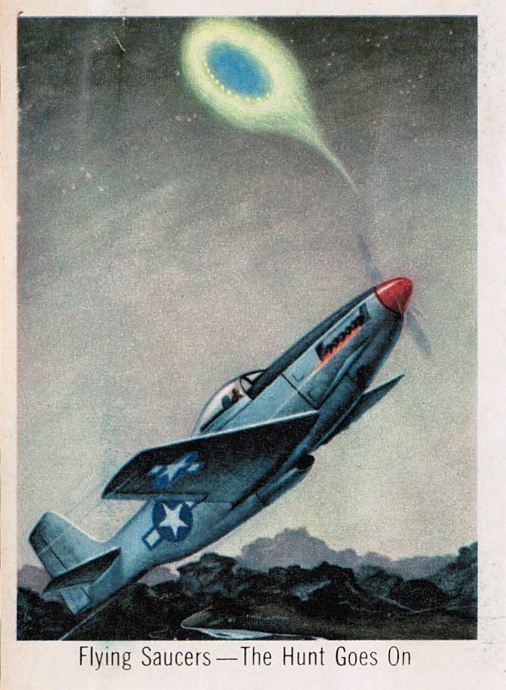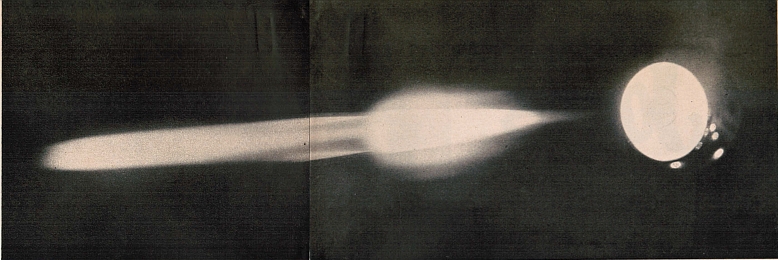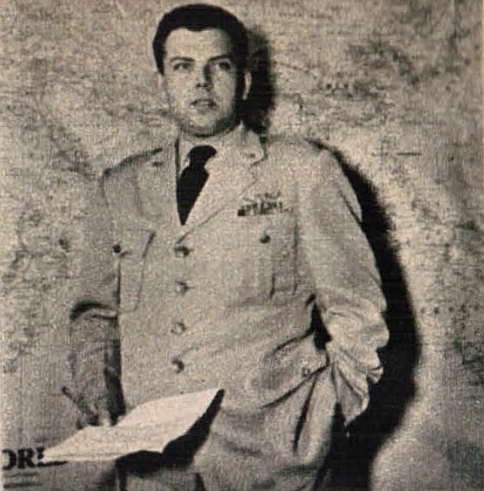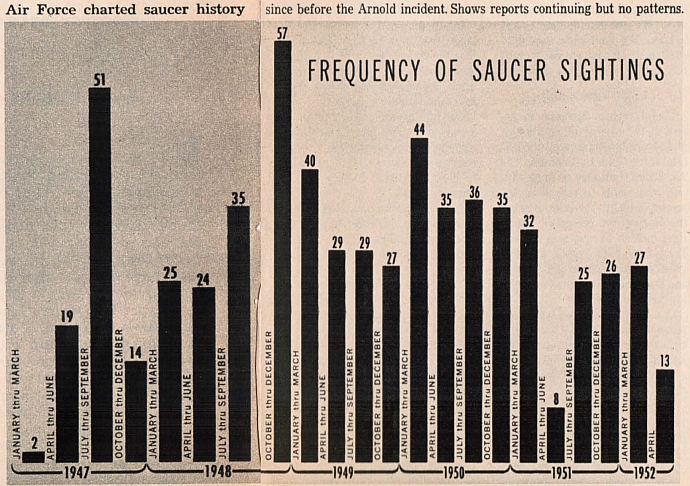


The U. S. Air Force, entrusted with the defense of the United States from the skies, is mounting a new hunt for the mysterious, seen-but-never-caught “flying saucers” which for five years have had Americans excited, baffled and even terrified.
During the past two weeks, Air Force officials have begun experiments to verify the radically new theory of Dr. Donald H. Menzel of Harvard University. This nationally-known astronomer suggested in the last issue of LOOK that flying saucers are actually optical illusions caused by “temperature inversion” which projects images of earthly lights on the sky. This has already proved one of the most exciting explanations of flying saucers offered to the Air Force.
Asked about the Air Force’s revived concern over flying saucers, after almost ignoring them for two years, Gen. Hoyt S. Vandenberg, chief of staff, in his first public statement on the subject, told LOOK:
“The Air Force is interested in anything that takes place in the air. This includes the aerial phenomena commonly known as ‘flying saucers.’ Many of these incidents have been satisfactorily explained. Others have not. With the present world unrest, we cannot afford to be complacent.”
The Air Force has collected more than 800 sightings of flying saucers, and reports continue to flow in from our outposts like Alaska and Newfoundland and from our vital atomic installation sites. They are spurring the Air Force to seek answers to the saucer puzzle in a hurry.
This is a job for the detectives of the Air Force, the officers of the Air Technical Intelligence Command, working behind a shield of secret planning and classified documents at heavily-guarded Wright-Patterson Air Force Base outside of Dayton, Ohio. Now for the first time exactly what Air Force Intelligence is doing about flying saucers can be revealed. As one highly placed intelligence officer put it, “Our job is to detect any weapon that might be used against the United States. In the future, a weapon that ‘probably was a meteor’ may prove to be a global rocket.”
Visual sighting reports can never give Intelligence accurate data on speeds, altitudes, size and composition of the objects seen. To get these facts, a methodical and scientific plan of great breadth has now been blueprinted. It includes these steps:
1. Under ATIC direction, a physicist at the University of California at Los Angeles is developing and testing a special camera to photograph flying saucers. Key to the new apparatus is a defraction grid consisting of a piece of glass etched with infinitely fine lines. Placed over the camera lens, this grid breaks down the image into slivers from which scientists can determine its composition. If the saucers prove to be bodies which glow, the grid will record the material they are made of. If their light comes from a fuel supply or a reflection, the grid will identify the light.
Among the first to be tested will be Dr. Menzel’s theory that saucers are, in reality, lights bounced upward from the earth’s surface. As Dr. Menzel independently suggested, the first defraction-grid cameras will be located in the southwestern U.S., which has had a concentration of saucer sightings. Two hundred cameras will be built and distributed to atomic-plant guards, airbase tower operators and radar men. Pictures will be sped to scientists who will then be able to give the world its first incontrovertible word on flying saucers.
2. Cine-theodolites, the instruments with which the Air Force tracks guided missiles, are also being converted to the hunt for flying saucers. Tracking crews will be able to fix their exact location and movement patterns and then photograph them with cameras built into the theodolites. Equipment and personnel at established guided-missile stations have already been alerted.
Theodolites attempted to track saucers on at least three occasions during the spring of 1950 at Holloman Air Force Base, New Mexico. One crew, after completing a guided-missile problem, was closing up shop when it picked up an unexpected object. The crew tracked it but could not fix it because no other instrument was operating. Four weeks later, two tracking crews caught an unexpected image, but checking proved that each had been following a different object. At least eight unknown objects were in the air. Pictures were taken but have not been made public.

3. The Air Force hopes to put radar in the flying saucer hunt on a big scale. Radar sightings have been recorded at key places like Oak Ridge, Tenn., and Goose Bay, Labrador. ATIC can never be certain whether such reports actually stem from a sighted object, weather conditions or equipment malfunctions. By combining existing radar, telescopes and cameras, photographs can be taken of any solid objects spotted in the daytime and of glowing objects at night.
4. Modified Navy sonar sound-detection equipment will be used. The absence of any reported sound is one characteristic of most reports on flying saucers. All known aircraft can be heard even when they are too distant to be seen. This strange pattern led one intelligence officer to suggest, “Someone may have discovered a new type of propulsion.”
Whatever results are obtained from the electronic and mechanical genius of cameras, theodolites, radar and sonar the Air Force will place before a special board of scientists. This panel will cut across scientific fields and will be established from among 200 scientists and engineers at a Midwestern research institution already doing secret work.
The brand-new search for original scientific data is the climax of five years of official Air Force knowledge of the saucers. Air Force officers were aware of the phenomena well before they sprang into public print. During World War II, mysterious objects were reported seen over German rocket plants. Flying saucers blossomed into a national and international scare in June, 1947, when Kenneth Arnold of Boise, Idaho, reported sighting nine disks while piloting his private plane over Mount Rainier, Washington. But even 15 days before this nation-rousing event, flying saucers (then called silver balls) were seen over certain rural areas of communist-occupied Hungary.
When flying saucers, after Arnold’s report, threatened to cause a national panic, the Air Force grew alert. General Vandenberg, chief of air staff, Army Air Forces, became interested and Project Grudge (first known as Project Sign) was organized. This was a special $34,000 hush-hush project under which reports from all over the world were collected and analyzed for two years.
On January 7, 1948, the death of Capt. Thomas F. Mantell, Jr., caused a stir. Captain Mantell was killed chasing an unknown object in his P-51 near Godman Field, Ky. (A drawing of this incident by LOOK artist Leonard Jossel is on the cover of this issue.)
In August, 1949, the Air Force decided to close down Project Grudge. It compiled the data on 375 sightings in a report which asserted that flying saucers did not exist and attributed sightings to “misinterpretation of various conventional objects,” mass hysteria, war nerves, hoaxes, hypnosis, illusions, vertigo, publicity stunts and psychopathological persons.
The report gave these reasons to all of the 375 sightings but 34.
These 34, the report said, were “good reports that could not be explained.” They still baffle Intelligence today. But the 1949 report put Project Grudge on the shelf.
Some of the scientists consulted did not agree with the Air Force decision. Their recommendation, stated in the report, was that the search be continued. Two scientists felt that no conclusions could be drawn from the evidence.
Then, last October, two intelligence men in the Unconventional Aircraft Group, Aircraft arid Propulsion Section, Technical Analysis Division of the Air Technical Intelligence Command, discovered that they had nearly 800 reports gathered in their files — more than twice the number on hand when the 1949 report was written. Interest and activity spurted forward and have now reached the highest levels of the Pentagon.
Project Grudge was revised (its name was changed to Project Blue Book on March 25 of this year) and in charge was placed 1st Lt. Edward J. Ruppelt of Ames, Iowa, a World War II B-29 bombardier with two Distinguished Flying Crosses, 33 combat missions and a degree in aeronautical engineering from Iowa State College.

Project personnel immediately set about studying their 800 sightings. They found that the reports have come from scientists, airline pilots, plain civilians, Air Force fliers, balloon observers and radar operators. Most have come from the United States but others from Russia, Africa, Japan. India, Australia and even Antarctica.
One intelligence colonel put ATIC's feelings bluntly, “These reports came from sincere people. They are not crazy; they are not crackpots. They are seeing something; we have to find out what.”
Analysis of the 800 sightings aims at discovering clues about the saucers. The reports have been broken down on 16,000 cross-filed cards and have already been analyzed for frequency of sightings, types of informants and reported shapes. The Air Force now knows, for example, that 18.03 per cent of the reports came from general military personnel, 11.02 per cent from Air Force pilots while aloft. Surprisingly, untrained civilians have been responsible for only 57.08 per cent of the reports over five years.
The Air Force has also learned that 23.54 per cent of the reports noted disk or sphere shapes, 8.25 per cent cigar or rocket shapes, 2.55 per cent flying wings and 0.6 per cent groups of lights.
They also found that 3S per cent could be classified as astronomical bodies, 13 per cent as balloons, 10 per cent as too nebulous to be valuable, 22 per cent as birds and aircraft, etc., 2 per cent as hoaxes and 15 per cent as “unexplained.” The unexplained 15 per cent puzzle the Air Force.

ATIC officials permitted me to go through hundreds of these reports. Most of them are rather simple to figure out or are too incomplete to be useful. But the reports called “good, unexplainable” completely stump Air Force Intelligence. Lieutenant Ruppelt says, “We just don’t have the facts to know. We don’t know enough to sluff them off and we can’t reach conclusions. We have to find out.”
Useful reports continue to arrive at the rate of 10 per month; all saucer reports received at ATIC total three times that number. The Air Force continues to urge anyone who wants to report an unknown object in the skies to reach the intelligence officer or operations officer at the nearest Air Force base. Such reports are teletyped immediately to Washington and Dayton. All informants’ names are kept confidential.
One high intelligence officer explained, “We want all the information we can get all the time. We will consider the seemingly craziest ideas. Someone may spot something important.”
To this General Vandenberg added, “The Air Force greatly appreciates the effort of many sincere and public-spirited individuals who have offered their assistance.”
Lieutenant Ruppelt keeps 63 sightings on the top of his file. These are the most detailed and most mystifying They come from pilots, ship observers, an Air Force colonel, civilian scientists, weather observers and intelligence officers. None of these 63 can be identified with any certainty. If the Air Force tosses them off with some easy guess, there is always the fearful chance that they will be missing a dangerous bet.
These sightings were pinpointed on a map. Soon afterwards, it was seen by a Pentagon representative who noted that a number of concentrations duplicated exactly the area of atomic energy installations. The Pentagon man excitedly reported back to his headquarters. A conference was called immediately in Washington.
Intelligence had to tell the Pentagon that they had no evidence that the flying saucers are spying on or threatening our atomic program. But this fear still lies deeply in some responsible minds.
One intelligence officer, thinking aloud, said, “This may be Russian reconnaissance but why would they want to risk a weapon like this just to look at Atomic Energy Commission plants. If we could fly 5,000 feet over Russian atomic installations and observe the shapes, sizes and locations of their buildings, we could tell what’s going on inside.
“The joker is that just about all of this information has been made public about our atomic work. The Russians don’t have to fly over our A-bomb plants.”
In their search for an answer, intelligence men have tried, without success, to correlate the unexplained sightings with publicity about flying saucers, increased war tension, tides, or atomic bomb detonations. None of them fits. They offer no pattern, no explanation that satisfies the experts. And long ago, the Air Force gave up the easy idea that all the excitement is just the result of mass hysteria.
Arrangements have now been made for ATIC headquarters to receive immediate word of every new sighting. If early reports, replying to a carefully designed questionnaire, suggest that a trained investigator might gain more facts from first-hand checking, an intelligence officer is sent to the scene. In recent weeks, trips have been made to Minneapolis, New Jersey, Columbus, Chicago, Detroit, Long Island and Texas.
Especially puzzling have been the horizontal-flying “green fireballs” which have been reported at Roswell. N. M.; Falls Church, Va.; Cedar Keys, Fla., and Albuquerque, N. M. Another branch of the Air Force, the Air Research and Development Command, with headquarters in Baltimore and laboratories in Boston, has been studying them in a secret project called Project Twinkle. Although work on this project has been completed, the ARDC refuses to make public its findings. All a spokesman for the ARDC will say is, “We have nothing that proves the existence of flying saucers.” But something called “green fire-balls” does exist, many Intelligence officers insist.
Some Air Force officials feel the inconclusive Project Twinkle report will never be made public; they won’t explain why. Some suggest it would expose a foul-up.
The Air Force refuses to jump at any conclusions on saucers. As the colonel in command of the ATIC put it recently, “Sometimes this project sounds like it belongs to the Air Defense Command, sometimes like the National Inventors Council. But we get stuck with the mysteries.”
Air Force officers feel the final solution to the flying saucer mystery will be found under one or more of the following headings:
1. Flying saucers can turn out to be misinterpretations of known objects. These have already caused many reports. People sighted balloons. jet planes and such and excitedly called them saucers.
But such misinterpretations cannot explain many of these sightings. Even the most cautious Air Force authorities feel certain that many people are not describing the behavior of any conventional form of aircraft, not even an aircraft on the most experimental drawing boards. No aircraft known, they point out. travels at such high speeds, gives off no noise, and maneuvers with the high acceleration and sharp, even square, turns that have been reported.
2. The mystery may prove to be caused by phenomena of nature or optics. Most promising is the theory proposed by Dr. Menzel that saucers are aerial mirages created by light reflections. Other natural possibilities are: electrical discharges in the upper atmosphere; unusual meteorites, or a new position of the earth in the universe, causing phenomena which mankind has never before experienced and therefore cannot identify.
Lieutenant Ruppelt says, “We expect Dr. Menzel's theory to solve some of these cases. We hope it will solve all of them.
“If the saucers turn out to be natural phenomena, we will drop out and hand the problem over to the scientists. But if they turn out to be ‘hostile vehicles’ we will keep after them.”
3. Saucers could prove to be man-made. They may turn out to be a foreign development, most possibly Russian, although no one will rule out scientifically advanced nations like Sweden, Switzerland, England, France or Italy. Lt. Ruppelt adds, “If these are man-made, whoever is making them is way ahead of us technologically.”
Or, although this is constantly and emphatically denied, they may be part of a secret U.S. development project. Intelligence officers admit that if a project were secret enough they would deny even its existence. But an informed intelligence officer said recently, “I’m quite sure there is no secret project. There is more chance that they are from Mars than from a project of ours. But we don’t know. This could all be an elaborate cover-up for something no one wants explained, but I doubt it.”
4. Flying saucers could be interplanetary spaceships or missiles. Air Force intelligence men say they are continually astounded by the number of trained scientists who believe they are interplanetary in origin. Lieutenant Ruppelt says he has talked with hundreds of scientists and heard many such theories.
He adds, “We can deal with these things if they are from Russia. If they are from Mars, I don’t know what we will do. We have no proof that they could not come from outer space and must include this among our possibilities.”
Air Force Intelligence says, whatever the flying saucer is — mirage, misidentified aircraft, freak of nature, enemy weapon or spaceship — the Air Force cannot move to counteract it until it has determined accurately what people are seeing. This is the hunt being mounted now.
Lieutenant Ruppelt sums up, ‘The only conclusion we have come to so far is that ‘flying saucers’ are not an immediate and direct threat to the U.S. They have been around for five years and haven’t struck yet. But that doesn’t mean they are not a potential threat.”
END